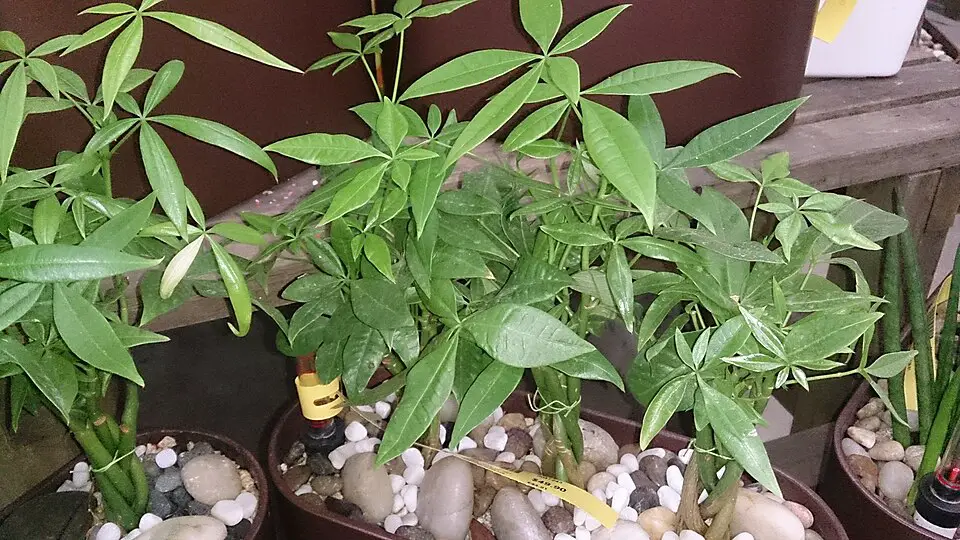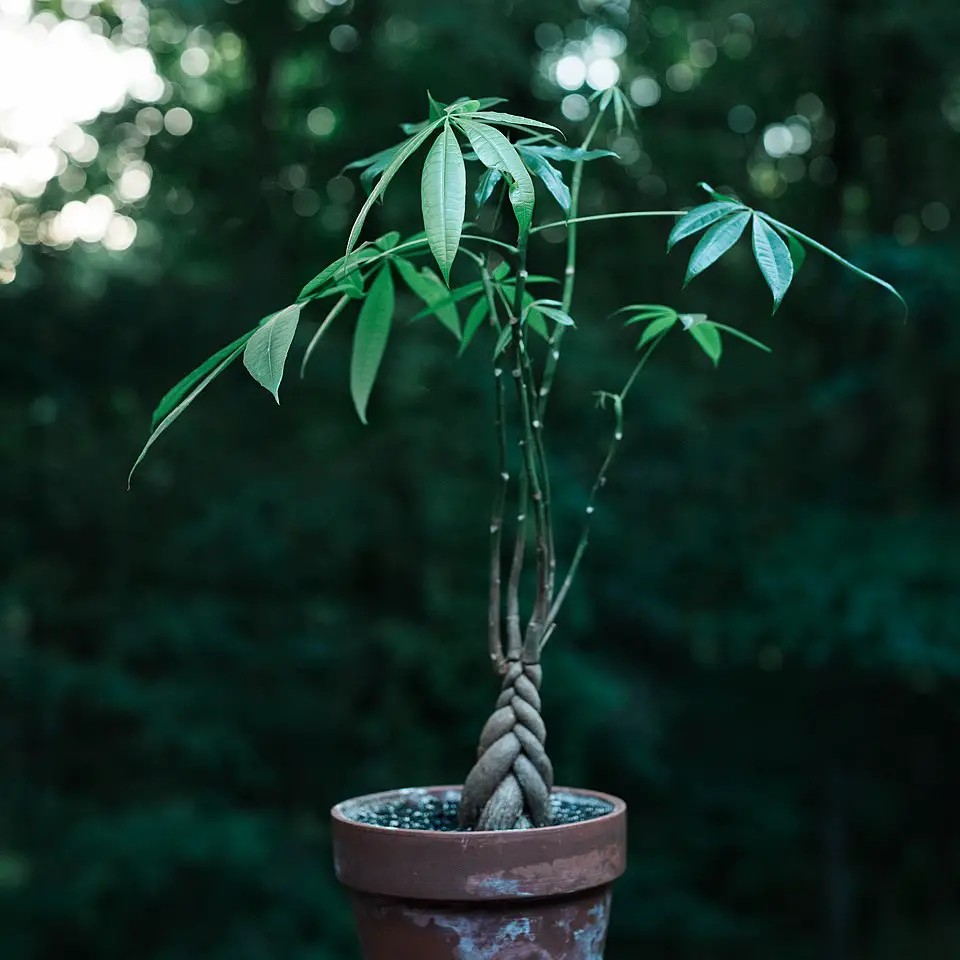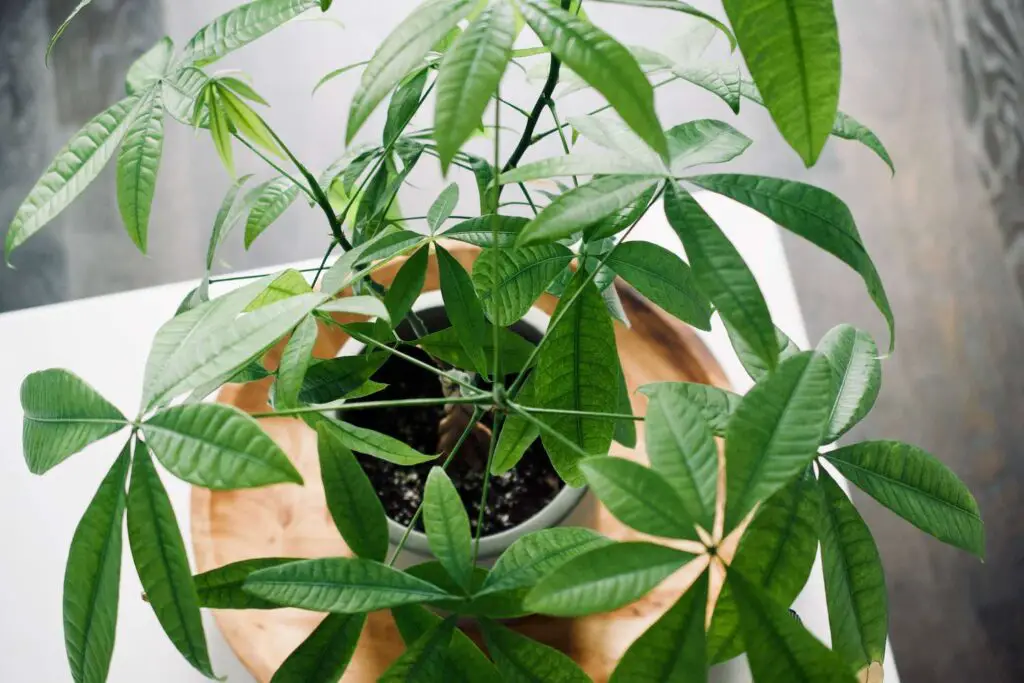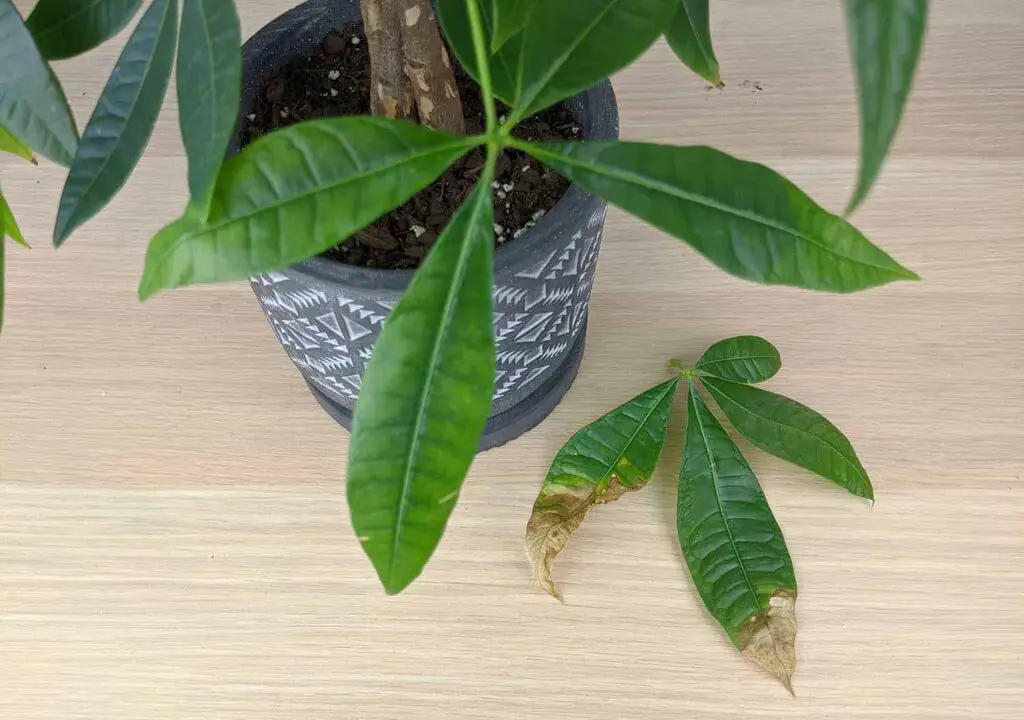The variegated money tree plant can be identified by its unique leaf patterns, which feature a mix of green and cream or yellow hues. The leaves are typically broad, hand-shaped, and glossy, showcasing distinct color variations that make this plant visually striking.
Understanding the Variegated Money Tree Plant
The variegated money tree plant, scientifically known as Pachira aquatica, is a popular indoor plant that belongs to the Malvaceae family. This tropical plant is native to Central and South America. It has gained immense popularity due to its attractive foliage and the belief that it brings good luck and prosperity. The variegated variety stands out even more because of its stunning leaf coloration, which can make it a focal point in any room.

Variegation refers to the presence of different colors in the leaves of a plant. In the case of the money tree, variegated leaves display a mix of green with creamy or yellowish patches. This unique characteristic sets it apart from the standard green money tree, making it a desirable choice for plant enthusiasts.
When trying to identify a variegated money tree plant, there are several key features to observe. These include leaf shape, color patterns, growth habit, and overall health. The following sections will explore these features in greater detail.
Key Identification Features
- Leaf Shape: The leaves of the variegated money tree are typically palmate, resembling a hand with five to seven leaflets radiating from a central point. This distinctive shape is consistent across all varieties of money trees.
- Color Patterns: The most notable feature is the variegation itself. Look for leaves that combine vibrant green with creamy or yellowish areas. Each leaf can have a different pattern, adding to the uniqueness of the plant.
- Growth Habit: Variegated money trees tend to grow upright with a sturdy trunk. As they mature, they may develop multiple stems, creating a bushier appearance.
- Overall Health: Healthy variegated money trees exhibit bright colors and firm leaves. Wilting or discoloration can be signs of stress or poor care.
Caring for Your Variegated Money Tree
Caring for a variegated money tree is essential to maintain its health and vibrant appearance. Here are some basic care tips:

- Light Requirements: These plants prefer bright, indirect light. Too much direct sunlight can scorch the leaves, while too little light may hinder their growth.
- Watering: Water the plant when the top inch of soil feels dry. Overwatering can lead to root rot, so ensure proper drainage.
- Humidity: Variegated money trees thrive in humid environments. If your home is dry, consider misting the leaves or using a humidifier.
- Fertilizing: During the growing season (spring and summer), use a balanced liquid fertilizer every four to six weeks to promote healthy growth.
Common Issues and Solutions
Like all plants, variegated money trees can face certain challenges. Here are some common issues and their solutions:
| Issue | Solution |
|---|---|
| Yellowing Leaves | Check for overwatering or inadequate light. |
| Wilting Leaves | Ensure proper watering and check for root rot. |
| Pest Infestations | Inspect regularly and treat with insecticidal soap if needed. |
By understanding these key features and care requirements, you will be well-equipped to identify and nurture your variegated money tree plant effectively. This knowledge not only enhances your gardening skills but also enriches your experience as a plant owner.
Variegated Money Tree Plant Varieties
The variegated money tree plant comes in several varieties, each with its own unique characteristics. Understanding these varieties can help you identify the specific type you have or wish to acquire. Here are some notable variegated varieties:

- Gold Variegated Money Tree: This variety features bright yellow and green leaves. The gold variegation is particularly striking, making it a popular choice for collectors.
- White Variegated Money Tree: With creamy white patches on deep green leaves, this variety offers a more subtle contrast. It adds elegance to any indoor space.
- Mixed Variegation: Some plants display a combination of both gold and white variegation. This variety is highly sought after due to its unique and unpredictable leaf patterns.
Each of these varieties has its own care requirements and growth habits. Understanding these differences can enhance your ability to cultivate a healthy plant.
Growth Conditions for Variegated Money Trees
To successfully grow a variegated money tree plant, it’s essential to provide the right conditions. These plants thrive in specific environments that mimic their native habitats. Here are the key growth conditions to consider:
- Soil Type: Use a well-draining potting mix. A blend containing peat, perlite, and pine bark is ideal for retaining moisture while allowing excess water to escape.
- Temperature: Variegated money trees prefer temperatures between 65°F and 75°F (18°C to 24°C). Avoid exposing them to drafts or sudden temperature changes.
- Light Exposure: While these plants enjoy bright, indirect light, too much direct sunlight can scorch their leaves. Position them near a window with filtered light for best results.
- Watering Schedule: Water when the top inch of soil is dry. Ensure the pot has drainage holes to prevent water from accumulating at the bottom.
Propagation Methods
If you’re looking to expand your collection of variegated money tree plants, propagation is an excellent option. There are several methods you can use to propagate this beautiful plant:
- Stem Cuttings: Take a cutting from a healthy stem that has at least two leaf nodes. Allow the cutting to callus for a few hours, then place it in water or directly into soil. Keep the soil moist and in a warm location.
- Air Layering: This method involves creating a small wound on a healthy stem and wrapping it with damp sphagnum moss. Cover it with plastic wrap to retain moisture until roots develop.
- Seed Propagation: Although less common, you can propagate money trees from seeds. Plant seeds in well-draining soil and keep them moist until germination occurs. This method may take longer than others.
Pest Management for Variegated Money Trees
Pest infestations can pose challenges for your variegated money tree plant. Knowing how to identify and manage pests is essential for maintaining its health. Common pests include:

- Aphids: These small, soft-bodied insects can usually be found on new growth. They suck sap from the plant, causing leaves to curl or become distorted.
- Spider Mites: These tiny arachnids thrive in dry conditions and are often found on the undersides of leaves. Look for fine webbing and tiny yellow spots on the foliage.
- Mealybugs: These pests appear as white, cotton-like masses on the stems and leaves. They can weaken the plant by feeding on its sap.
To manage these pests effectively, consider the following strategies:
l>
By learning about the different varieties, growth conditions, propagation methods, and pest management strategies for your variegated money tree plant, you will be better prepared to ensure its success in your home or garden.
Common Myths About the Variegated Money Tree Plant
The variegated money tree plant has garnered a lot of attention, leading to various myths and misconceptions about its care and characteristics. Understanding these myths can help you better care for your plant and avoid common pitfalls.
Myth 1: Variegated Money Trees Are Difficult to Care For
Many believe that variegated plants are inherently more challenging to care for than their solid-colored counterparts. While they do have specific needs, such as adequate light and humidity, they are not significantly more difficult to maintain. With the right care, including regular watering and appropriate lighting, you can keep your variegated money tree healthy.
Myth 2: The More Variegation, the Better
Another common belief is that more variegation means a healthier plant. This is not always true. Excessive variegation can sometimes lead to weaker growth because the plant has less chlorophyll to produce energy through photosynthesis. A balance between variegated and green leaves is often healthier for the plant.
Myth 3: Money Trees Only Bring Good Luck
While it is widely believed that money trees bring good luck and prosperity, this belief is part of folklore rather than fact. The plant’s positive energy can uplift a space, but its health and growth depend on proper care. The idea of luck should not replace the need for regular maintenance and attention.
Environmental Impact on Variegated Money Trees
Environmental conditions play a crucial role in the health of your variegated money tree. A few key factors can significantly impact its growth and appearance:
Light Quality
The quality of light is essential for the vitality of a variegated money tree. Insufficient light can lead to leggy growth and diminished leaf coloration. Conversely, too much direct sunlight can scorch the leaves. Here are some tips for managing light:
- Indirect Light: Place your plant near a north or east-facing window where it can receive bright, indirect light.
- Rotate Regularly: To ensure even growth, rotate the plant every few weeks so all sides receive adequate light.
- Avoid Direct Sunlight: If you notice yellowing or browning leaves, it may be a sign of sunburn from too much direct exposure.
Humidity Levels
Variegated money trees thrive in humid environments. Low humidity can lead to issues such as leaf drop and pest infestations. Consider the following methods to increase humidity:
- Misting: Lightly mist the leaves with water a few times a week to boost humidity levels around the plant.
- Humidity Tray: Place a tray filled with water and pebbles underneath the pot. As the water evaporates, it will add moisture to the air.
- Group Plants: Keeping multiple plants together can create a microclimate with higher humidity levels.
Seasonal Care Adjustments
The care requirements for your variegated money tree may change with the seasons. Adapting your care routine can help ensure optimal growth throughout the year.
Spring and Summer Care
During the growing season, your money tree will require more attention:
- Increase Watering: As temperatures rise, check the soil more frequently and adjust your watering schedule accordingly.
- Fertilization: Apply a balanced liquid fertilizer every four to six weeks to support new growth.
- Pest Monitoring: Inspect your plant regularly for pests, as they can become more active during warmer months.
Fall and Winter Care
As temperatures drop, your plant will enter a period of dormancy:
- Reduce Watering: Cut back on watering frequency, as the plant will need less moisture during cooler months.
- Lower Fertilization: Fertilize less frequently or not at all during this time to prevent overfeeding.
- Maintain Temperature: Keep your plant away from cold drafts and ensure it remains in a warm area of your home.
By understanding common myths, environmental impacts, and seasonal adjustments needed for your variegated money tree plant, you can enhance its growth and overall well-being while enjoying its beauty in your space.
Enhancing Your Variegated Money Tree Experience
C
aring for a variegated money tree plant is not just about providing the right environment; it also involves understanding and appreciating the unique beauty this plant brings to your home. Beyond basic care, there are additional ways to enhance your experience with your variegated money tree.
Decorative Potting
The pot you choose for your variegated money tree can significantly affect its aesthetics and overall health. Consider these factors when selecting a pot:
- Size: Ensure the pot is large enough to accommodate growth but not so large that it retains excess moisture.
- Material: Terracotta pots are porous and allow for good drainage, while ceramic pots can add a decorative touch and retain moisture.
- Design: Choose a pot that complements your home decor. A stylish pot can enhance the visual appeal of your plant.
Creating a Suitable Environment
Beyond lighting and humidity, creating a suitable environment can further promote the health of your variegated money tree:
- Air Circulation: Ensure good air circulation around your plant to prevent mold and pests. Avoid cramped spaces.
- Companion Plants: Consider grouping your variegated money tree with other houseplants that enjoy similar conditions. This can create a lush, green display and help maintain humidity levels.
- Seasonal Decoration: Enhance your space by decorating around your plant seasonally. Use decorative stones, fairy lights, or themed decor to celebrate different times of the year.
Monitoring Plant Health
Regular monitoring of your variegated money tree’s health is crucial. Here are some tips for keeping an eye on your plant:
- Daily Checks: Spend a few moments each day observing your plant. Look for changes in leaf color, texture, or overall vigor.
- Photographic Record: Take photos of your plant periodically. This can help you track growth patterns and identify any issues over time.
- Networking: Join online gardening communities or local plant clubs. Sharing experiences and tips with others can provide valuable insights into caring for your variegated money tree.
Conclusion
The variegated money tree plant is a stunning addition to any indoor garden, offering both beauty and a sense of tranquility. By understanding its unique characteristics, care requirements, and common challenges, you can cultivate a thriving plant that enhances your living space.
Key takeaways include recognizing the different varieties of variegated money trees, providing optimal light and humidity conditions, and adjusting care routines with the seasons. Additionally, dispelling common myths about these plants empowers you to appreciate them fully and care for them properly.
Ultimately, nurturing a variegated money tree is not just about meeting its physical needs; it is also about enjoying the journey of growth and transformation this beautiful plant embodies. With patience, observation, and love, you can ensure your variegated money tree flourishes and remains a cherished part of your home for years to come.
